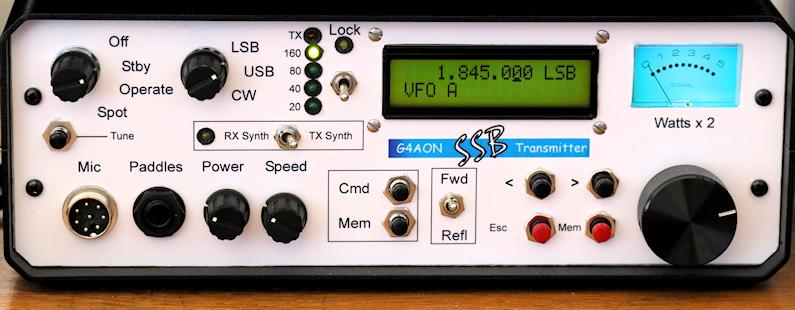
Note: synth kits from both Cumbria Designs and SDR Kits are no longer available. Also the PA module kits from
QRPproject!
are not available as they have ceased trading.
Design
Much of the circuitry in this transmitter is similar to my other TX and RX, being "3rd generation" means some of the design is an improvement over the earlier circuits. The SSB and CW generation dates back several years to a 14 MHz transceiver in QST by Wes Hayward. Steve, G4GPY, has also built one of these transmitters and it sounds great on air.
This transmitter covers the 160, 80, 40 and 20 metre bands and provides both SSB and properly generated CW. The CW side of this transmitter is not compromised and produces excellent CW. On SSB the audio has been tailored to provide a rising response to 3 KHz, with a sharp drop above that frequency. There is RF speech clipping to both provide more "punch" and to limit the peak output.
The sideband and CW generation in this transmitter design is based on circuits from Experimental Methods in RF Design by the ARRL and reproduced with permission. The original article used 9 MHz IF filters, we used an IF of 8.215 MHz due to being able to source filters at a reasonable cost. Any similar SSB bandwidth filters in the 8 or 9 MHz range, both with the same centre frequency, could be used. The control circuitry is similar to that used in my Companion Transmitter and is based on the MK2 Universal QRP Transmitter that appeared in the April 2006 edition of QST.
Crystals and filters can be a little tricky to source, the filters were from eBay suppliers and came from scrapped Yaesu transceivers. The crystals for the carrier oscillator board were obtained from Elecraft, they are normally used to build 5 pole filters for their K3. For those with deep pockets, new filters and matching crystals could be purchased from Inrad.
Being of modular design, and including print board layouts for the boards, means you can use these in your own design or substitute existing boards into this design. None of the parts are scarce. For those with a copy of Sprint Layout, you can edit the board layouts to suit different parts... Especially the filter boards to suit whatever capacitors you can source. The view only version of Sprint Layout can be used to print the board layouts.
The SDR Kits synthesiser has band data output which provides auto lowpass/bandpass filter switching via a 4 to 16 line decoder board. The active band is shown via a set of front panel LEDs, if space is a premium a single LED could be used with parallel diodes to indicate "valid band" or similar.
All the board layouts in Sprint Layout 6 format are in a zip file here Note, the bandpass board has been changed to v6 and a W1EL "K16" board layout added. The change to the BPF board is to replace the 65pF trimmers in the 20m BPF with 22pF ones.
The main features of this design are:
| Modular construction giving flexibility for updates |
High frequency stability |
| Adjustable power up to 10 Watts |
Can be built for additional bands |
| Rugged PA from an easy to build kit |
Built in CW VOX and keyer with side tone and memories |
| Compatible with many boat anchor receivers |
Transceives with my Universal Receiver |
| Choice of several synthesizer kits |
Low spurious output |
| Full control of timing, no hot switching, no shortening of first "dit" on CW |
Built in SWR and power metering |
The final amplifier is the QRP-PA 2008 kit by QRP Project producing up to 10 Watts on all bands. The synthesizer is a kit from SDR-Kits. If a similar synthesizer is used in a receiver (such as my Universal RX), then this transmitter will transceive using the receiver's synthesizer, indeed if the band data from an SDR-Kits synth in a receiver is fed into this transmitter's decoder board it will band switch from the receiver too.
Much of the circuitry is the same as my Companion Transmitter, although I decided to build it for only four bands and to scratch build the low pass filter. The transmitter can be used on any of the HF bands if the appropriate filters are used, those from the Companion Transmitter would be fine and could give a 10 band transmitter. CW VOX control is included, with full timing control and rise/fall times of around 4 mS. There will be a delay of roughly 10 mS from key down to RF appearing, the internal keyer can compensate for any shortening of the initial CW character. On SSB only PTT is included.
The worst case harmonic is in the region of 58 to 60 dB below peak output (160m second harmonic), all the rest are very low. It also has excellent carrier and unwanted sideband suppression.
The block diagram in PDF format is here
Click here for a top view and Click here for an underside view
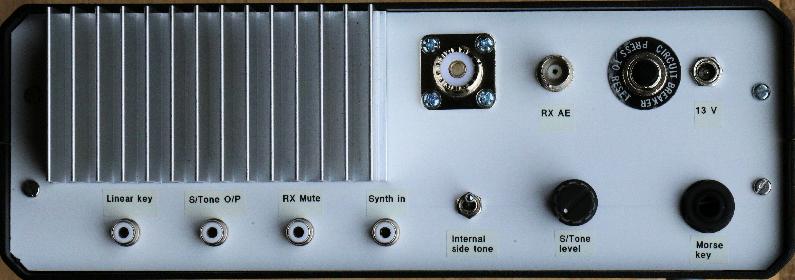
The case used is a "Unicase 2" by Metcase (www.metcase.com), part number M5502119, which measures 260 x 90 x 250mm (W, H, Depth). If building one for more than 4 bands a larger case may be needed. These cases are stocked in the UK by RS Components (769-4908). An aluminium sheet is fitted in the centre of the case, this is not supplied with the case. The knobs are from eBay suppliers. The "signal" meter is from Maplin, with illumination by a white LED.
The front panel was printed on photo card and glued to the aluminium panel with 3M photo mount spray adhesive. A clear plastic self adhesive "book protector" film protects the card from fingerprints and moisture.
Some test equipment is essential to the building of this transmitter, it is hard to build something as complex as this with only a basic multimeter and SWR type power meter. Some, or all, of the following will prove useful:
An L/C meter to measure capacitors and inductors (an LC200A from eBay is adequate and costs around £25),a grid dip oscillator to more accurately measure iron dust cored inductors, a spectrum analyser with tracking generator, or signal generator and spectrum analyser (or possibly a general coverage receiver if an analyser is not available) to align and check the band pass filters, a power meter and 50 Ohm load, a low cost multi-meter and a frequency counter. An oscilloscope to check the timing of the TX control board and to check the peak output doesn't exceed 10 Watts. If you are unable to obtain a spectrum analyser, or even a signal generator, it is possible to build the filters and hope they will be OK, however it's a good idea to be able to test each module of the transmitter is working correctly before final assembly.
Power distribution board
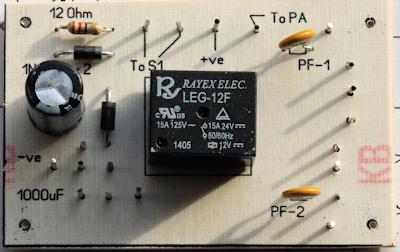
This board is the same as used on the Companion Transmitter, although I have used a different type of relay. The diagram is here. An electrolytic capacitor, such as a 4700uF 25V one, should be connected from the PA pin to -Ve. Those with Sprint Layout can edit the layout to suit other relays, there is an alternative relay layout on my Companion TX page.
Control board
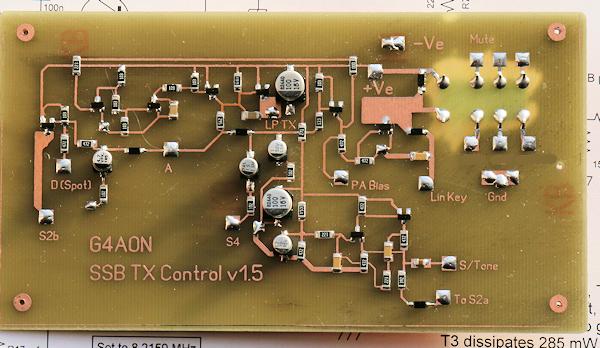
This control board uses common parts and while being surface mount the parts are 1206 size with plenty of space... It could be soldered with an ordinary soldering iron if necessary. The relay is a Panasonic DS2Y-S-DC12V (available from several sources including RS Components), which has a 720 Ohm coil and a 4 mS operate time, note the polarity of the coil. The TX LED is connected via a 2.2K resistor to the large pad under "+Ve", it's the relay coil connection that is grounded on TX.
Sidetone is built into the control board and feeds a rear panel phono socket, this can be fed into a suitable receiver to provide headphone/speaker sidetone from the RX. Note, the keyer will need a small speaker for setting up purposes, the sidetone on the control board is inactive when configuring the keyer. A earphone from a scrap pair of headphones makes an ideal and cheap speaker to use with a K1EL keyer board, and can be glued to the over current trip.
The linear keying line is suitable for a modern linear such as an Elecraft KPA500, it is not suitable for older amplifiers. There is no compensation for slow relays in old linears. It is built on double sided PCB with plain copper underneath to carry the ground connections, grind or countersink the area of the relay (which mounts under the board). The diagram is here
Timing is well controlled on CW, the control circuitry is the same as my Companion Transmitter. An oscilloscope view of the various Voltages is shown below:

Trace 1 (Yellow) is the internal keyer out, trace 2 (cyan) is the mute line output (note the slow rise, not a fault), trace 3 (magenta) is the RF output and trace 4 (blue) is the CIO oscillator board feed.
Keyer
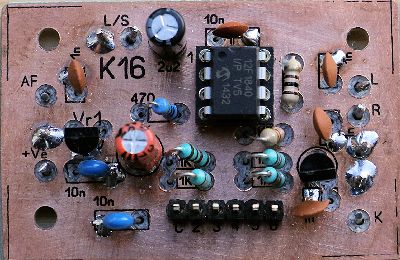
This board uses a K16 keyer i/c from K1EL. There is a board layout in the zip file at the top of the page. You can buy a complete kit of parts for this board from K1EL, those of us who may suffer from import taxes can buy the i/c and make our own boards. Note there are circuit differences between a K16 keyer and the earlier ones from K1EL.
SSB/CW generator board
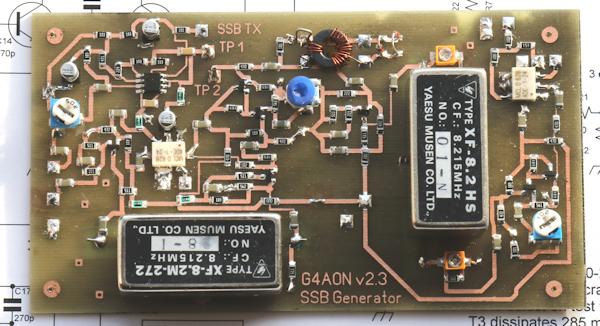
Also built on double sided board with a plain copper underside. The diagram is here
A Kenwood MC-43S dynamic microphone gives good quality audio, is low cost and drives this board easily. Note the change in value of C7 from 22uF to 4u7F in order to reduce low frequency noise. Beware of excessive mic level settings, with an MC-43S the mic input level (R1) should be set just above minimum and R29 (IF gain) set near max. It is easy to over drive the second half of the 5532 mic amplifier and produce in band IMD. Check TP1 with an oscilloscope to minimise distortion.
The output of the board is between -10 and -20 dBm, depending on the output gain preset (bottom right of board). With a two tone audio signal input, 100mV RMS each tone, the Voltages at TP1, TP2 and TP3 (drive to final ADE-1 mixer) are shown below, trace 1 is TP1, etc. The clipper limits the peak output and sounds very nice on a local receiver. 
Carrier insertion oscillator board
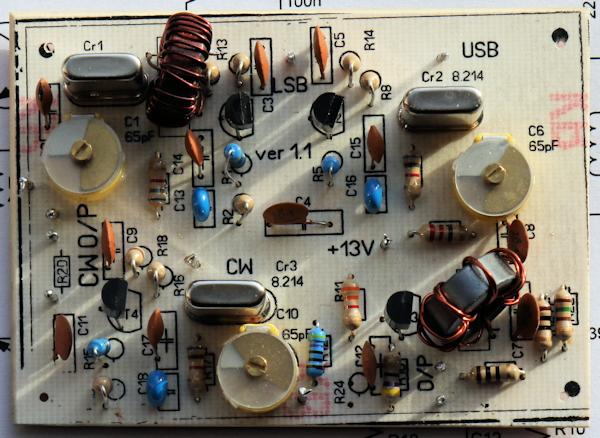
This is fairly conventional, note a select on test resistor needs adding to the above board (R20, CW level). The diagram is here
The crystals are from Elecraft and would normally be used to build K3 5 pole filters. The suggested frequencies shown on the diagram should be taken as a starting point, with final adjustment to give the best audio quality when monitoring on an adjacent receiver. The CW crystal should be set to give a carrier on the frequency indicated on the frequency display.
Decoder board
This is used with an SDR-Kits synth with firmware version 4.20 or later. Note that 4.19 and earlier SDR-Kits firmware used different band data output.
The board is fairly self explanatory and is a direct lift from the IC data sheet. It's also using double sided board to carry the ground connections. Note the through hole decoupling capacitors carry a ground to the transistors, their other leg is soldered to the top side of the board. The board includes outputs for 15 and 10m, as it's easy to include and may be useful at a later date.
Pin 1 of the band data output from the synth board goes to A3 on this board, pin 2 to A2, etc. Note the wire link from pin 1 to 24 on the board and the through board link to ground pin 12. While a HEF4514BT is shown, other similar chips could also be used. Currently, at Jan 2016, the ic is available from RS Components for 81p plus vat. The MMBT4401 transistors are 12p plus vat from RS (in quantity 10 off, or 6p each in 50 off).
The diagram is here. The layout is included in the zip file of boards (link at top of this page).

Synthesizer
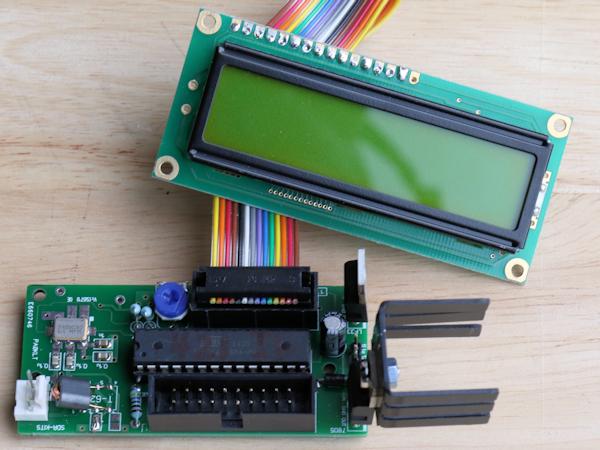
I've used an SDR-Kits synth based on an Si570. It's a fairly easy to build kit and is realistically priced. The parts count is quite low, the above image shows the complete synth and it's display, the vacant connector is used to connect the rotary encoder, band data output and push buttons. One of the limitations of this particular kit is the fixed USB/LSB/CW offset, these are +/- 1.5 KHz and +/- 750 Hz, these offsets may not be suitable for your particular IF filter. The Voltage regulator (bottom right of image) tends to run quite hot, with the addition of a simple heatsink the temperature is dropped to around 40 deg C.
The kit includes a mechanical encoder, which isn't anywhere near as good as an optical encoder. SDR-Kits offer an optional Bourns 32 step optical encoder which works fine. These Bourns encoders have closely spaced pins which are hard to solder, there is an easy solution (other than buying a dedicated plug/lead at a similar cost to the encoder itself)... It is easy to etch a small board to spread out the connections to pads (image below), there is an etching pattern in the zip file of board layouts further up the page.

The band decode output lends itself to automatic band switching - saving one front panel switch... With firmware 4.20 the dial lock feature removes the IF offset! I am using firmware 4.21 that locks the dial correctly. Ask for version 4.21 (or later) when ordering, the standard version is 4.20 (March 2016).
The output of the SDR-Kits synth is quite high, typically +12 to +14 dBm, the output needs attenuating to both provide the correct level and to give a good 50 Ohm termination to the mixer. There is a 3 dB pad shown in the diagram which can be changed to 6 dB or an additional 3 dB added, resistor values for attenuators are available from several web pages. If you use the optional change over relay (to use an external RX synth), consider adding 3 dB of attenuation to the synth output to give +10 dBm before switching it.
Si570 based synths have excellent frequency stability, I have three units which all use the lowest cost Si570 (CAC000141DG, CMOS) with a spec of 50 ppm. In practice they are very stable and move typically 1 or 2 Hz per hour in a centrally heated house. Even the initial warm up drift is only around 20 Hz. The output of an Si570 is a square wave, those of us more used to the sine wave output of a typical VFO need not worry, a square wave drives a diode ring mixer without any problems and may have less IMD than using a sine wave drive.
Optional switching between the internal synthesiser and an external one in the Companion Receiver is accomplished with a double pole change over relay switched using a front panel mounted toggle switch. The un-used synthesizer (or buffer) output is terminated in a 50 Ohm resistor to minimize stray RF.
Note the optional switch (S5) on the control circuit diagram marked "calibrate". The SDR-Kits synth is awkward to calibrate when there is an offset applied (as in SSB or CW operation), opening switch S5 takes off any mode offset to make calibration easier. The switch can be mounted internally, or a link could be used.
Band Pass Filters
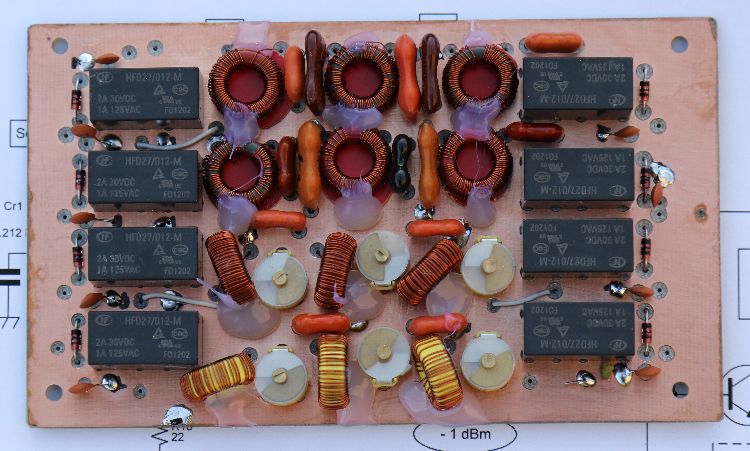
This is a four band version of the same filters as used in my other transmitter and receiver. Details of the circuit values are here. Two of the response curves are shown below and are measured via the board in/out contacts. The insertion loss of the 80m and 40m filters are between the figures for 160 (the least loss) and 20 (the highest loss). The above image shows 65pF trimmers in the 20m filter, the board layout in the zip file has been altered to use 22pF sized trimmers, which are easier to tune. Under the board are pads to add attenuators in order to match the loss across the bands, adding attenuators may not be necessary but the pads are there if needed.
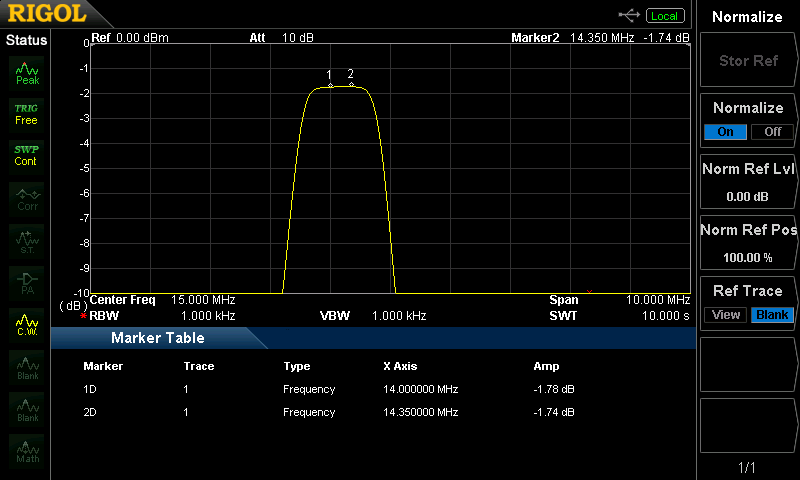
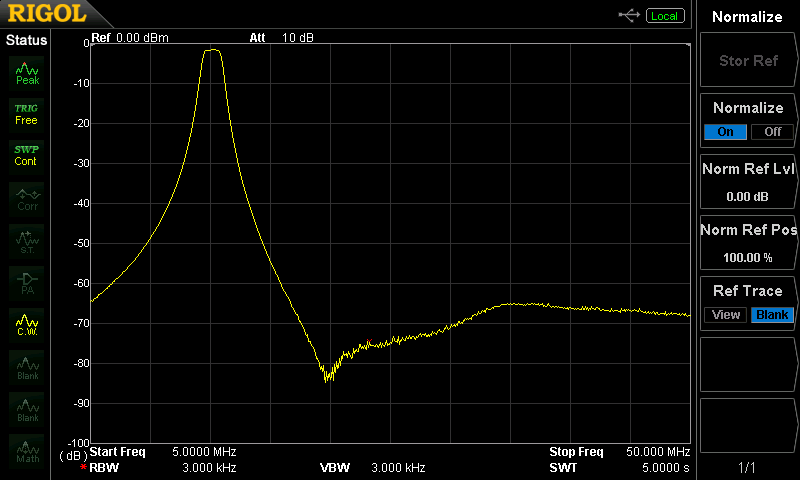
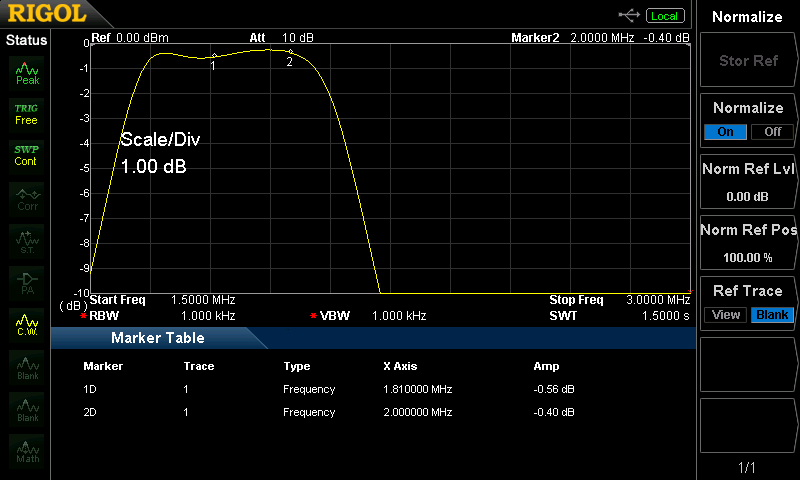
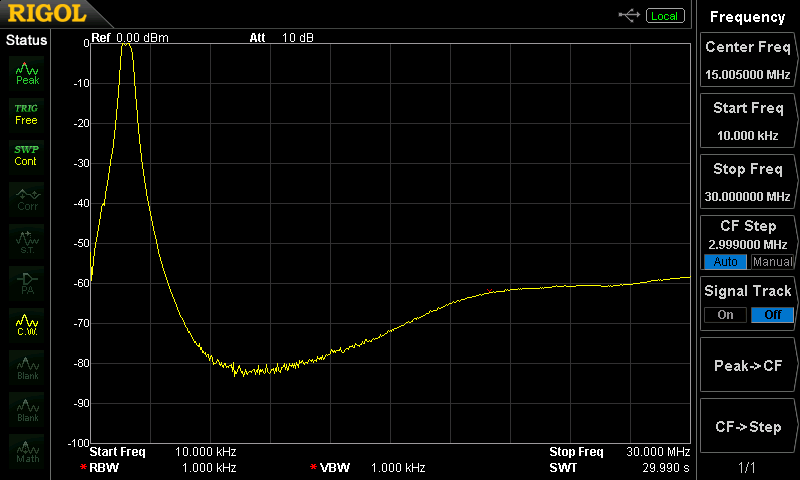 Low Power Amplifier
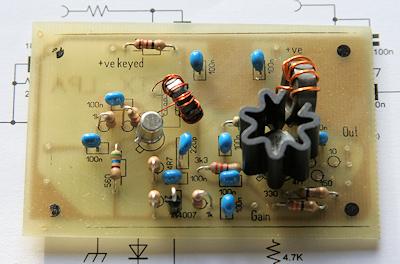
Another identical board to that used in my Companion Transmitter. The diagram is here.
This amplifier is based on a design in Experimental Methods in RF Design, by the ARRL. The original design had a far from flat frequency response curve and was a poor match to the 50 Ohm band pass filters. By careful tweaking of the components of the first stage, the amplifier can give a response which is flat to within 1 dB from 1 MHz to 30 MHz. The gain ranges from approx 20 to 30 dB depending on the setting of the power control, that includes the loss through the 3dB output attenuator. The 1N4007 behaves as a PIN diode in this circuit allowing for gain adjustment between typically 2 and 10 Watts from the PA (the lower power level depends on the band pass filter loss). The image above shows a second board assembled and tested prior to fitting in a transmitter. The 3 dB output attenuator resistors are mounted under the board, the layout in the zip file has a little more space to allow the resistors to be mounted top side.
The 100nF capacitor that was in series with the 1N4007 diode in the original circuit has been reduced to 10nF, this is to remove a momentary spike in power level that occurred at the leading edge of each character when the power level was set around 75% of full power.
If you are struggling for power on higher frequencies when using this amplifier board, do not increase the value of C1 beyond about 220 pF. Too much capacitance between the emitter of the BSX20 and the 1N4007 will create a spike at the leading edge of the transmit envelope due to momentarily increasing the Voltage on the anode of the diode. The better solution is to add a capacitor of between 1nF and 4.7nF across the 4.7 Ohm resistor on the emitter of the 2N3866. Also, do not remove the output attenuator as this provides a better match between the low power amplifier and the following PA amplifier.
Power Amplifier
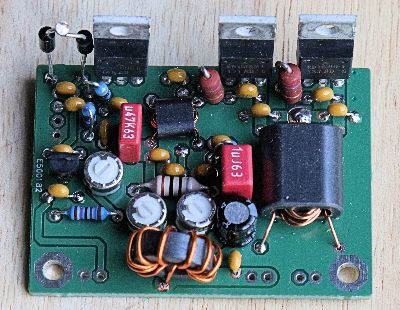
This is a German kit using Mitsubishi VMOS transistors, it produces 10 Watts out for 10 mW (+10 dBm) input. There is no SWR protection as the transistors can withstand a high SWR without failure, I've used one in my Companion Transmitter for several months without any issues.
The transistors are bolted to an aluminium heatsink approximately 111mm wide x 60mm high and 25mm deep
There is a link to QRPproject! at the bottom of this page.
Low Pass Filter
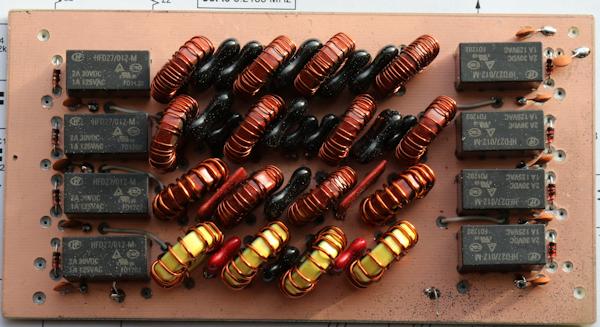
The filters are 7th order Chebyshev low pass filters, designed using the Elsie program. I opted to use a Chebyshev design as it's less critical than a Cauer. Using an inductor input configuration, while requiring 4 coils to be wound, means there are less capacitors to source. Each section was soldered into the board and tested before moving on to the next. The board is plain copper on top with appropriate holes countersunk to provide clearance for the component legs.
The layouts for this board use T68 sized toroid cores (T68-2 for 160/80/40 and T68-6 for 20m). In addition, the layout was done to suit the capacitors to hand including 2 or 3 in parallel to make up the correct value. The capacitors are all silver mica with most obtained from Rapid Electronics in the UK.
The diagram and values used in the filters is here A typical plot is shown below, this is the 40m low pass filter.
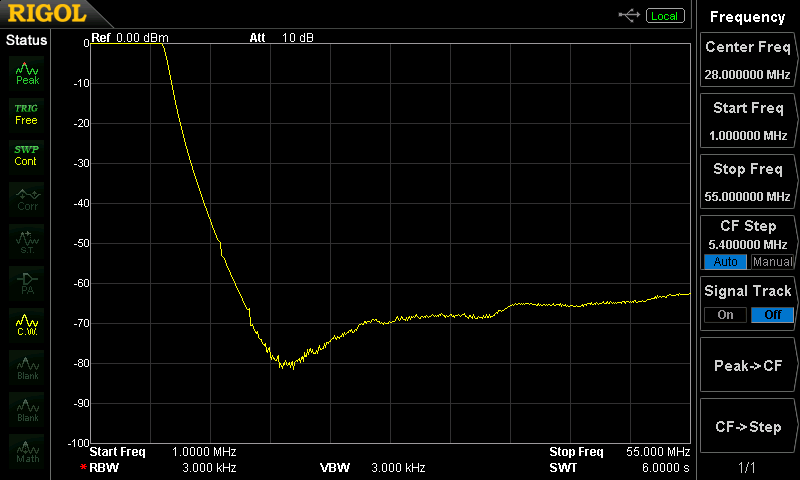
SWR and Power Board
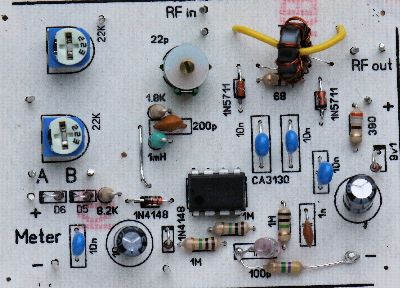
This is the same as used in my Companion Transmitter. It uses a fairly basic "average reading" circuit and as such tends to give a better indication on CW than SSB. If I were building this transmitter again, I would use a twin bargraph LED meter to show forward and reflected together. One such circuit is this one, http://www.w6pql.com/led_bar_graph_meter.htm. However, that kit would be awkward to fit and an edge mounted LED display would save a lot of front panel space.
The diagram of my meter circuit is here. Note R26 has been changed from the earlier circuit to 10K, R27 removed and R31 added (4.7M to ground from pin 3 of the i/c). C19 can be reduced in value to give a more responsive meter, probably 4.7 uF is better than the 10uF originally shown in the diagram. The board layout has been updated to include these changes.
The output of an SWR and Power measuring bridge is amplified with a CA3130 operational amplifier. The meter output is fed via D5 and D6 to improve the linearity. My meter is a basic "signal" meter marked 1 to 5, which corresponds to half the measured output power. C12 is adjusted for minimum reflected power when terminated with a 50 Ohm dummy load. R28 can be reduced slightly if you cannot obtain full scale with 10 Watts output. R23 and R24 set the forward and reflected levels.
In common with other builders of SWR meters like this one, if you find the forward and reflected readings are reversed, swap the RF in/out cables.
Construction tips
The print boards were produced using a low cost laser printer and heat transfer paper, the paper is available from eBay traders and typically costs less than 15 GBP for 100 x A4 sheets, including delivery. The method is well described elsewhere, but basically you print a reverse image onto the shiny side of the paper and iron it onto the copper side of the print board. Allow to cool (I put the board under a cold running tap) and peel off the paper, it leaves behind the laser toner which is etch resist. Touch up any gaps with an etch resist pen and etch in ferric chloride. You can be clever and print the component layout on the top of the board with this method too! The board layouts are in Sprint-Layout 6 format, there is a view only version of the program, that can be used to print existing files, on the Abacom web page... look on the program description at the Abacom site (link at bottom of page).
I've used a mixture of surface mount and through hole construction, I used whatever method was either easier or cheaper. SMD parts are low cost as is a hot air soldering station. Solder paste for SMD work is critical, many suppliers on eBay sell useless paste. I used Multicore brand paste (available from RS, CPC, Farnell, etc.) and it's excellent.
This transmitter was built as a one off, with circuits and print board layouts to help anyone else who wishes to use them. As such it isn't intended to be a "Heathkit" project where you slavishly follow the diagrams, switch on and find it works! Most of the boards can, and should, be assembled and tested before wiring them together. The critical points to watch for are:
1. While I have taken care to check the board layouts are correct, please double check them yourself before etching. Some of the print board pads are quite small, feel free to increase their size if your drilling and soldering is a bit shaky. The board layouts are intended for home printing/etching, I have no idea if they are suitable for commercial board suppliers. Likewise the circuit diagrams are believed to be OK. If you have any questions I am only an e-mail away, however, this is a "do it yourself" project for experienced constructors and as such I can only offer limited support.
2. The output of the 2nd mixer, and the loss through the bandpass filters, are matched to the gain of the low power amplifier. If you cannot obtain -16 dBm from the mixer and less than 4 dB loss through the filters, the output will be low. Beware of high output from the synthesizer, attenuate it to suit the level needed for the 2nd mixer (+7 dBm).
3. Inductors wound on iron dust toroid cores can be tricky to measure, the problem is that most common LC meters use an oscillator around 500 KHz and that is very low compared to HF frequencies which can result in significant errors - especially on the higher frequencies using T50-6 cores. However, inductor values are easy to measure in the old manner of using a known value capacitor of good accuracy, such as a 1% silver mica one, then tagging the capacitor in parallel with the inductor and measuring the resonant frequency with a dip meter, it's then an easy matter of calculating the inductor value or using one of the on-line calculators. If the test capacitor is chosen to resonate the inductor near the planned frequency, then the results should be close to ideal.
4. Some components are becoming hard to source. ADE-1 mixers can sometimes be found on eBay, or failing that direct from Minicircuits, although there is a min order quantity of 20. Toroids can be obtained at a good price from the G-QRP Club (members only). Capacitors for the bandpass filters can sometimes be found on eBay, although their quality and tolerance can be quite variable. Recently Rapid in the UK have good stock of silver mica capacitors which are only specified as being 5% but were measured at around 1%. The heatsink and wire for the transformers and coils can also be found on eBay.
5. Either having a spectrum analyzer, or the loan of one from a fellow ham, makes alignment very simple. The relatively low cost Rigol DSA 815 TG was used in the construction of this transmitter.
6. Do not exceed a peak output of 10 Watts with the specified PA, the PA will probably not fail, but there will be excessive IMD and distorted signals. Most "peak reading" SWR meters do not accurately show peaks, use an oscilloscope connected via a simple resistive tap to see what is going out.
7. It's hard to give specific fault finding tips, the following pointers may be useful:
- Hard to set forward and reflected levels on SWR board and high levels of harmonics - check the bifilar wound core in the SWR circuit is correctly wound.
- Excessive loss through the lowpass filters - make sure you haven't accidentally added one turn too many to the coils. The "knee" of the response curve should be nicely above the top of the band, not in the band.
- Hard to tune/excessive loss in bandpass filters. I have built 3 sets of these filters and they all work as predicted by the Elsie program. Beware of being fooled by LC meters that give very convincing (but inaccurate) readings of inductance, remember most of these are running at 500 KHz (the one by Peak only runs at 200 KHz which is even worse), we are building filters for 1.8 MHz upwards...
- Hum and low frequency noise on transmit - might be caused by a lack of smoothing capacitor(s) in the power supply. The 4700uF 25V capacitor across the supply to the PA is a low ESR type from Panasonic and cured the above problem.
- If you appear to have too much drive, consider adding an attenuator between the band pass filters and the low power amplifier. Attenuators help to improve matching and are beneficial to good filter response shapes.
Finally if you build this transmitter please let me know how it works out. My contact e-mail is listed on QRZ.com
The circuit diagrams and board layouts were drawn using sPlan 7 and Sprint-Layout 6 from Abacom. Click here for a link to their site.
Elsie can be downloaded from here.
K1QW has a useful calculator for toroid inductors, it can be downloaded here.
K1EL, the keyer board, is here
The source of the PA board is here
And SDR-Kits are here
Please do not build this design without checking the values for yourself, in particular the band pass and low pass filter components. The information is presented here to assist experienced constructors who may wish to build something similar, it is not suitable for novice constructors.


|
